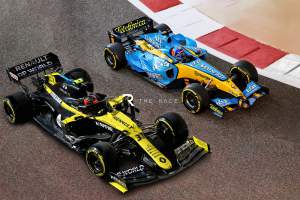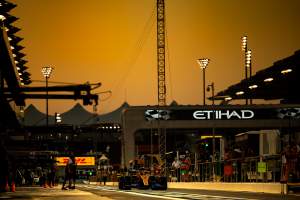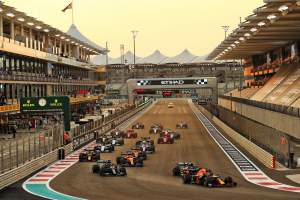Up Next

The Abu Dhabi track is notorious for how it locks in a race order almost as soon as the first lap shenanigans have played out.
On each of this weekend’s three days Fernando Alonso was demonstrating his glorious old 2005 Renault V10 – and someone quipped wouldn’t it be funny to send Vitaly Petrov out there in the 2010 car to get in his way.
The joke of course being how Alonso’s 2010 title bid with Ferrari failed here because of the difficulty of passing a slower car.
The DRS era has changed that a little – the DRS-assisted runs up the two straights on the respective approaches to Turn 8 and 11 now help a newer tyred car past an older one.
But between cars of close performance parity, around here you’re still locked in.
So Max Verstappen’s shading of the two Mercedes in qualifying was quite a momentous thing even beyond the status of beating Mercedes to pole in ‘normal’ circumstances (ie not when the Mercedes were 5s off the pace, as at Istanbul). It gave hope not only to Red Bull but all of Formula 1.
But could it win the start? Could it hold onto its tyre performance? Would the Mercedes inevitably prove the faster car, get ahead at the start and pull away, either with Valtteri Bottas or the returning Lewis Hamilton?
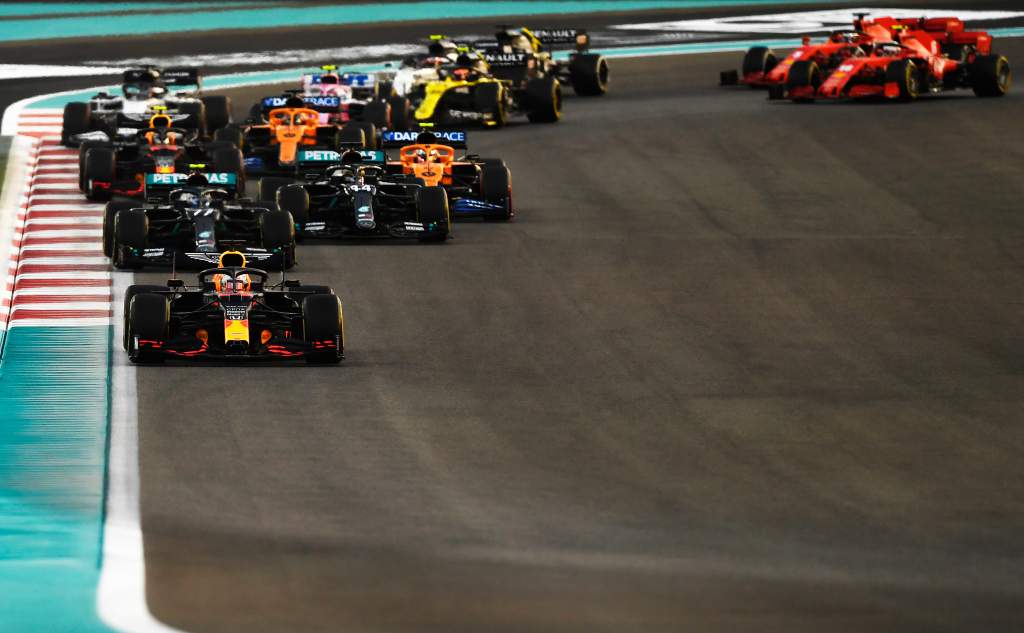
Even if it didn’t, would the twin assault of Bottas and Hamilton allow Mercedes to strategically pincer Verstappen, force Red Bull to choose which one to defend from, just as Ferrari had to choose between Sebastian Vettel and Mark Webber’s Red Bulls back in 2010? And chose wrong.
But it didn’t happen like that. From the twilight start to the black-sky finish, this was a dream of a race for Red Bull and Verstappen, as they comprehensively outperformed Mercedes on merit.
Maybe a fully fit Hamilton could have made up the difference, but the Red Bull was genuinely super-quick here
It was actually such a straightforward victory that it was dull for everyone else, a bit of an anti-climax to a season that has produced some great races.
Verstappen won the start, Bottas and Hamilton following in grid formation, all three on the medium tyre on which they’d been able to qualify in Q2.
Then the first of the soft runners: Lando Norris – having starred by qualifying the McLaren in fourth – keeping his place ahead of Alex Albon, but with the latter commenting on the radio how hard Norris was having to drive to stay there.
Here’s where DRS helped; the Red Bull was sufficiently faster than the McLaren after six laps of being pushed on the quick-degrading softs that Albon was able to put a straightforward move on it up to the Turn 8-9 chicane and to leave it well behind.
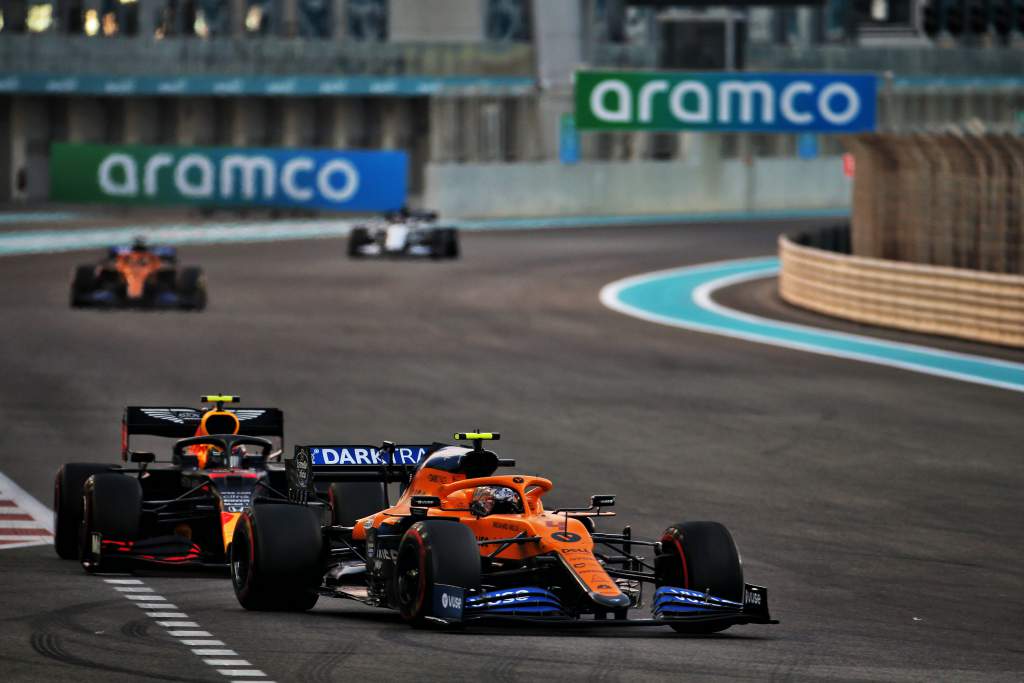
And that was it, really! The new Mercedes power unit in Sergio Perez’s Racing Point – which had started at the back after its winning Sakhir engine was found to be on the point of failure and replaced – stopped suddenly out on circuit on the 10th lap of 55, bringing out the safety car.
That was early for everyone to stop but feasible. Only those who had started on the hard (Daniel Ricciardo, Vettel and Kevin Magnussen) plus Charles Leclerc and Antonio Giovinazzi (on mediums) chose not to pit to take advantage of the cheap time loss a pitstop under the safety car offered.
The pitters (14 of the 19 remaining cars) all fitted hards, which could do the remaining 45 laps. That just locked in the order even more – as there was now not even any strategic variation between those who’d begun on mediums and those on softs, and they’d all have to treat the rubber nicely to avoid an extra stop. So no racing.
Ricciardo stayed out there for ages on his hards, in fifth a long way behind the pitted Red Bull and Mercedes quartet, and came back out with 16 laps to go, close enough behind the McLarens of Norris and Carlos Sainz Jr that it initially seemed feasible he might catch them.
But then the mediums lost their edge and the hards on the McLarens stayed rock solid and so even that potential battle petered out. It wasn’t going to be an action-packed race even without an indestructible tyre, but that certainly played its part in the stasis.
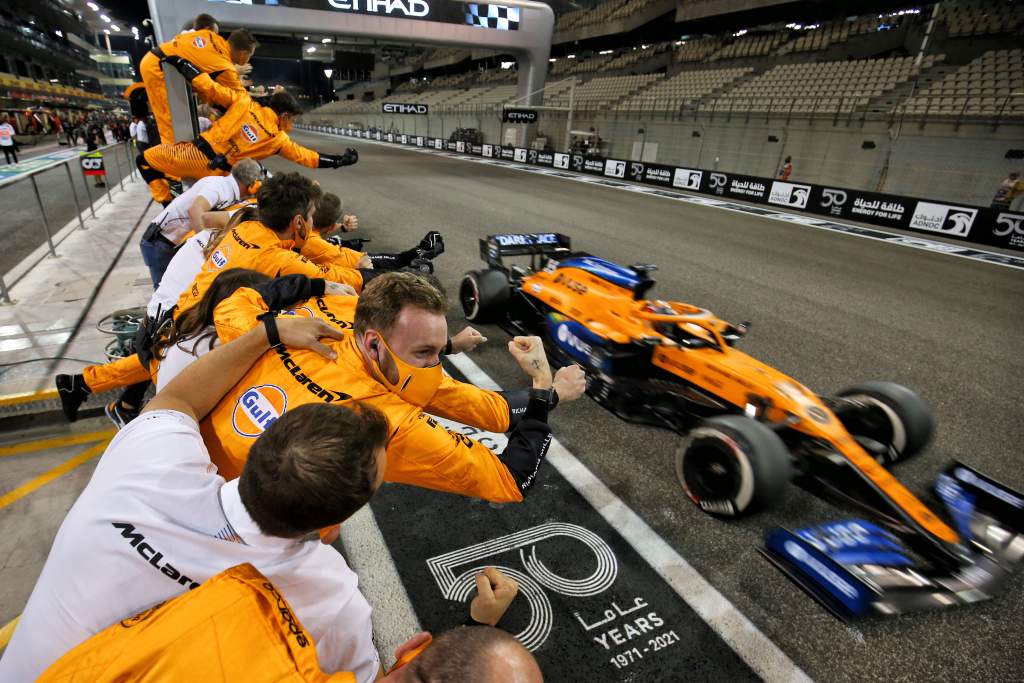
The Norris-Sainz fifth and sixth place finishes, combined with Perez’s retirement and a lacklustre race from Lance Stroll to 10th, ensured McLaren beat Racing Point to third in the constructors’ championship.
On this front-limited circuit Ferrari wasn’t in good shape, even Leclerc’s acrobatics not enough to get into Q3.
Having chosen to start on hards, there was no point Vettel pitting from the midfield at the safety car. But Ferrari left Leclerc out there too, on his mediums, reasoning that he’d be stuck in traffic all over again unless it tried something different.
He came past Vettel, got past Esteban Ocon but then wore out the fronts and was bumped back down the order. The Ferraris rejoined well down the order, made some progress then came up behind Kimi Raikkonen’s 12th-place Alfa.
Kimi wasn’t up for allowing Leclerc past and thereafter Leclerc’s tyres lost their performance all over again. So Alfa beat Ferrari, with Vettel in his last race for the Scuderia following his team -mate across the line, 13th and 14th.
Verstappen’s info was spot-on. There was a concern at Mercedes
There was no strategic tension up front. The only wheel-to-wheel action came lower down the field as old and new-tyred runners ran in and out of phase up through those DRS zones into Turns 8 and 11.
Meantime Verstappen scored a lights-to-flag victory, nearly 16s clear of the Mercedes by the end, Bottas ahead of Hamilton throughout.
The only thing missing from Verstappen’s litany of dominance was Ricciardo using his much newer tyres to ensure his last ever lap for Renault was the fastest of the race as he tripped the beam in seventh.

Other final goodbyes were Sainz’s with McLaren, Daniil Kvyat’s with AlphaTauri (he was passed early on by team-mate Pierre Gasly and finished 11th), poor old Perez’s with Racing Point, Vettel’s with Ferrari and Magnussen’s with Haas. The airwaves were awash with declarations of love and regret.
Ricciardo’s hard-medium strategy was definitely better than team-mate Ocon’s medium-hard. Ocon finished ninth behind Gasly’s AlphaTauri after a last lap pass on Stroll, having come in under the VSC while Ricciardo was able to stay out.
The theoretical advantage Ocon would still have had over the soft-tyre runners on race day was nullified by the early safety car not penalising those starting on the softs (hence also Norris staying ahead of Sainz throughout).
So that’s what happened. The way it happened on track was very routine, very Abu Dhabi.
But the actual result poses an obvious big, big question: how come Red Bull outperformed Mercedes?
Well, first of all there was qualifying. Verstappen shaded Bottas by 0.025s (with Hamilton, less than fully fit after his COVID bout, a further few hundredths behind).
Maybe a fully fit Hamilton could have made up the difference, but the Red Bull was genuinely super-quick here.
Using the single-pilar rear wing trialled in Bahrain, it was running very efficient downforce. It was getting down the straights unusually quickly for a Red Bull (even if that was not reflected in the speed trap because the Honda was clipping earlier than the Mercedes, as it usually does).
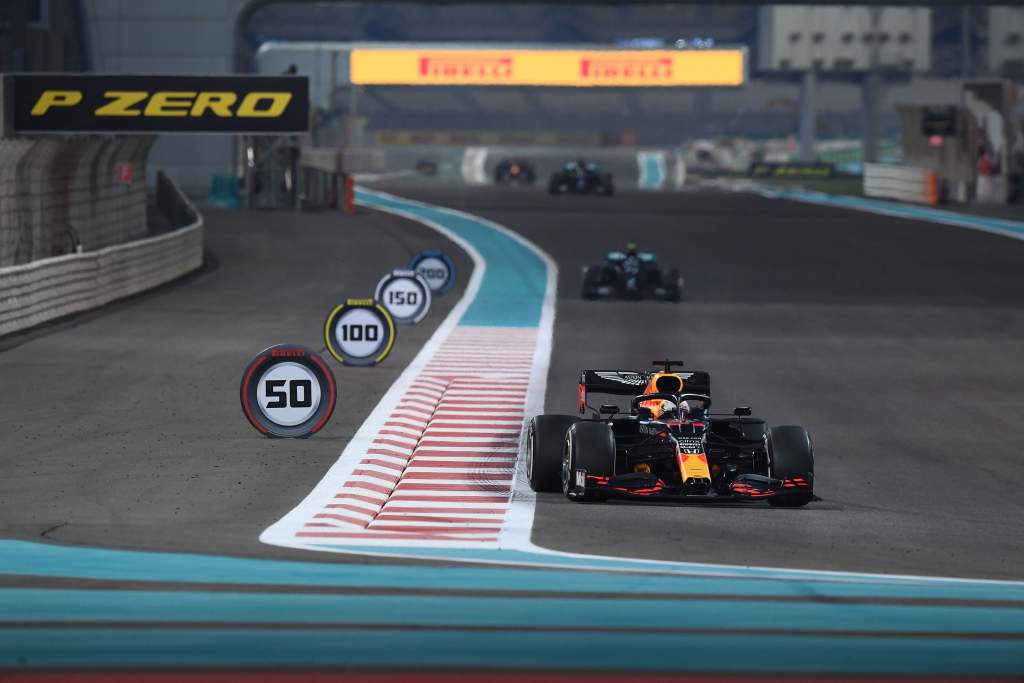
It’s not so much the terminal speed which is important, it’s how long it takes to get from the beginning of the straight to the end of it – and the Red Bull was doing it very quickly indeed, almost as quick as the Mercedes. Which is not normal.
This in combination with the car’s usual slow-corner alacrity so useful in sector three made it a formidable weapon here. It remained so in the race.
But it wasn’t just Hamilton than was less than fully fit. There were a couple of compromises with the Mercedes too. There has been a concern about the durability of the ERS-K for the last few races, it turns out.

It can be managed and it was running on full beans in qualifying. But it was turned down for the race – on all the Mercedes. And still Perez’s failed, and his was brand new.
Verstappen had heard all about it – and mentioned it in passing at the post-race press conference.
“What’s that about the engine?” queried Hamilton.
“The MGU-K,” said Verstappen.
“Us?”
“Yeah that’s what they said.”
“Is that right? I don’t think that’s the case.”
“Maybe it is,” offered Bottas, “but we don’t know.”
“Maybe they just don’t want to tell you!”
Verstappen’s info was spot-on. There was a concern and it was being run at less than full resistance for much of the race.
“Rather than being acutely aware of a specific problem,” explained Mercedes’ engineering chief Andrew Shovlin, “we are operating the power unit in a way that is as conservative as we can be in order to try and avoid a problem.
“But when you don’t understand exactly the string of issues, all you can do is be a bit cautious.
“So, during the race we were trying to reduce the duty marginally. The drivers wouldn’t have necessarily been aware of it. It was just something we were trying to manage in the background.”
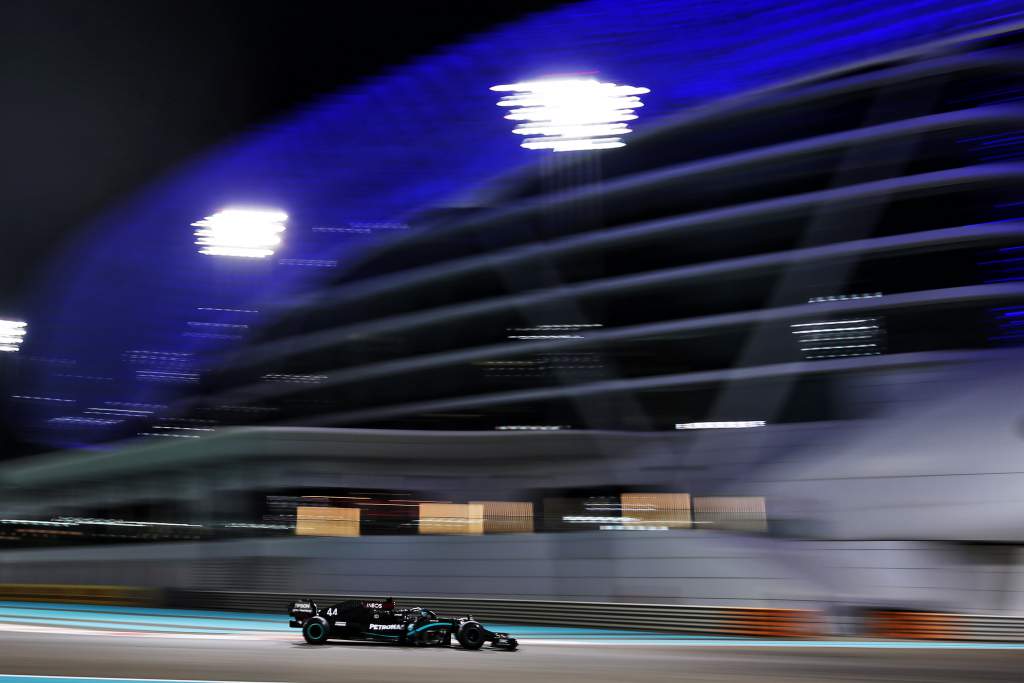
The other thing was, the Mercedes was just not balanced very well.
Neither driver had been able to fully utilise the greater grip of the softs in Q3. But even in the race, on the harder tyres, it was understeery and therefore eating further into its front tyres than the Red Bull.
It was losing 0.3s to the it through the Turn 5-6-7 left-right-left sequence. The Red Bull would then pull out further time under braking for Turn 8, thereby overcoming its earlier engine clipping on the straight.
“My body is not feeling great. But look on the bright side: I made it through and I didn’t think anytime last week I would be here…” :: Lewis Hamilton
So that’s how they proceeded, Verstappen pulling out a little each lap. But not too much.
“Always with a margin,” he explained, “because you knew that you had to do quite a lot of laps.
“So basically I was just looking at what the guys behind me were doing and of course I was trying to build a little bit of a gap, just every lap trying to get a bit out of it to have a bit of a safety margin in case your tyres suddenly drop or whatever.
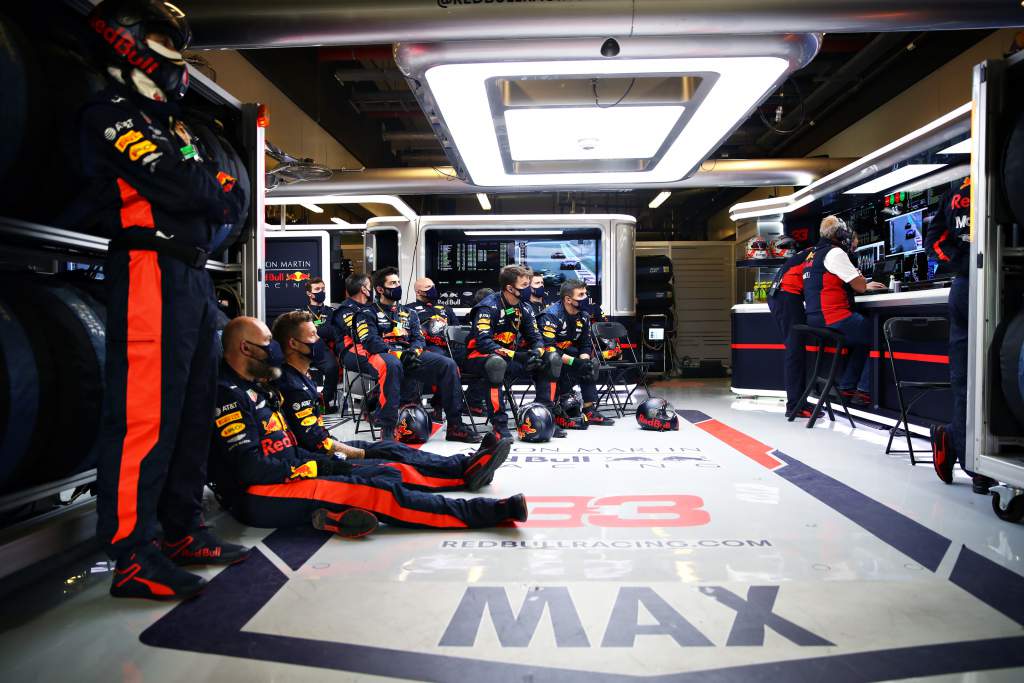
“But then you couldn’t go flat out on this track; you cannot do that because it’s just too hard on tyres and the last sector is quite tough. Of course the early safety car meant we had to make them last a long time as well.”
“As soon as you get within three seconds of someone you here you are just sliding around and you’re in turbulence the whole time,” said Hamilton.
“I really hope that what Ross [Brawn] has proposed [for ‘22] really makes a difference. We just need good tyres.”
Bottas was caught in the same trap, but soon realised there was no obvious answer to his conundrum.
“The first stint the car was understeery,” he said.
“We put more front flap on at the stop and it wasn’t bad, but just not quite quick enough.
“I could see that Max was pulling a gap and of course at the end I didn’t want that gap to grow too much and of course I tried to keep up, at the same time trying to make sure we make it to the end.
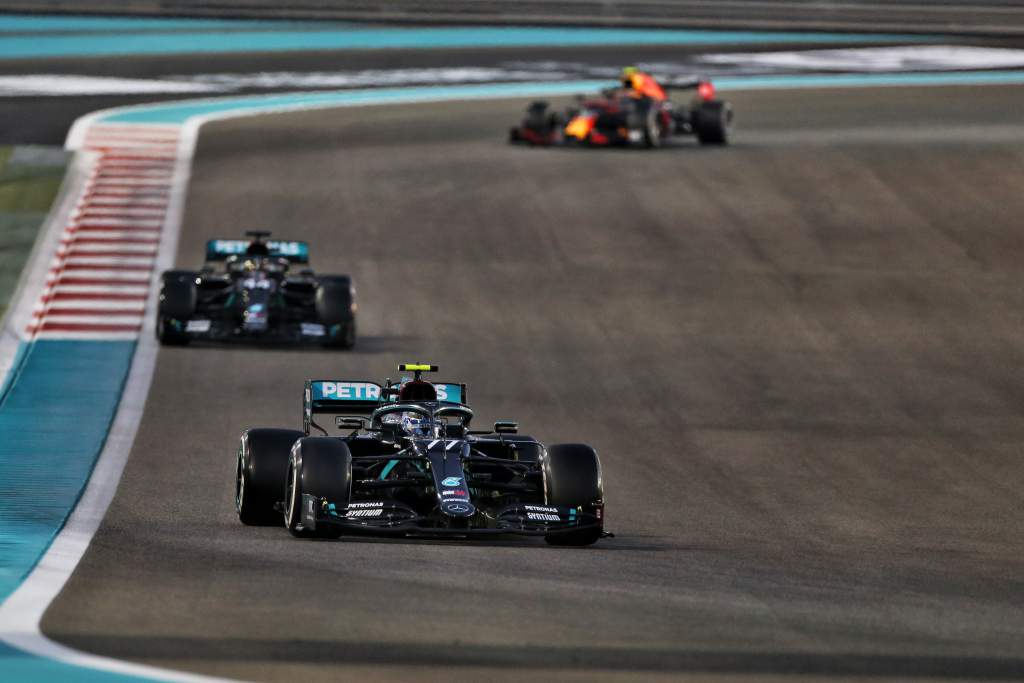
“So it was all balancing it out and at some point, the three of us, we can’t keep up with them and we need to try and get to the finish.
“If we had to do two stops we would have been a lot slower overall so there was not many options.”
And that’s where Albon came in. Because once he’d got past Norris he was able to run in the vicinity of the Mercedes. Not close, but in the neighbourhood, close enough to prevent either of them being able to gamble on a free stop, to try for a two-stop, or split strategy to put some pressure on Verstappen.
That is exactly what they would have done if Albon hadn’t been there. Which is exactly the support role that Red Bull needs from its second driver.
In Abu Dhabi Albon at last fulfilled that role. With his front tyres lasting better than those of the Mercedes he was even able to close within under 2s of Hamilton by the end.
“Considering the past couple of weeks I’ve had I’m really generally happy with the weekend,” said Hamilton.
“That was a really hard race for me, physically. All year, physically I have been fine but today I definitely wasn’t. So, I’m just glad it’s over.”
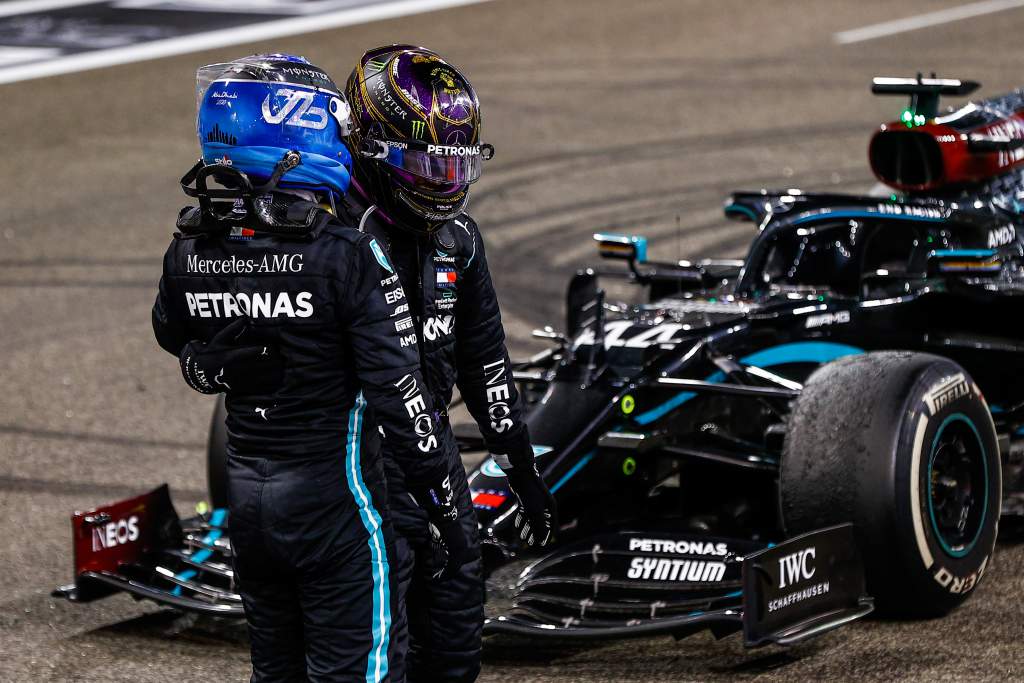
So it was a challenge?
“Physically? Yes, massively. I don’t think I’ve ever been so blown.
“My body is not feeling great. But look on the bright side: I made it through and I didn’t think anytime last week I would be here…
“I’m looking forward to recovering over the next period of time we have and getting back into training and get my body back to where I know it should be.”
Let’s hope there’s been a whole lot more recovery going on, not just with Hamilton, by the time the engines start up again in earnest.




